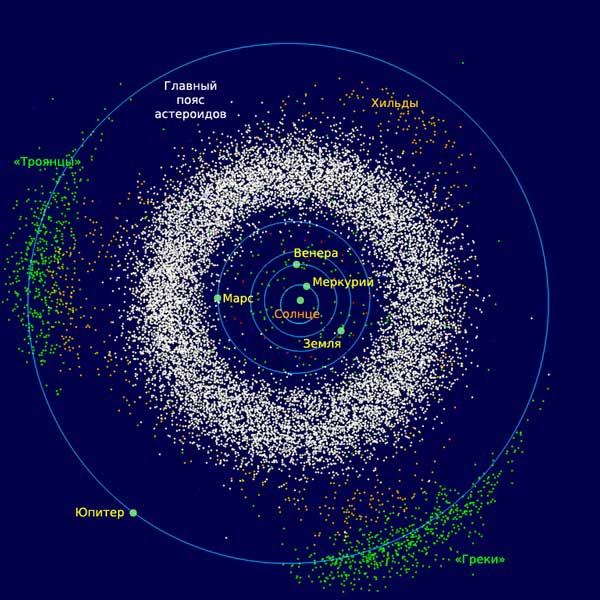A family of primitive asteroids is giving astronomers a window into the past as they seek to unravel the history of these small space rocks that are believed to have once brought water to Earth.
Life in the solar system can be dangerous because there have been many collisions throughout history — consider the giant impact that formed our Moon, for example, or the multiple impacts that have cratered Mercury. Occasionally, large asteroids in the main asteroid belt between Mars and Jupiter have also been hit. When this happens, these asteroids are broken into smaller pieces. Such events can produce dozens of smaller space rocks; naturally, many of the resulting pieces, all descended from the same original object, share some common features, such as following similar orbits. Astronomers call such groups of asteroids “families,” according to the April 2024 issue of the journal Icarus.
There are more than 120 such families known to exist in the asteroid belt. Some of them, such as the Vesta family, named after the second largest object in the belt, 4 Vesta, show signs of chemical changes. Vesta, being such a large family, underwent heating and a process known as differentiation, in which heavier elements sank into its core, forming different layers, before it was hit by another asteroid and partially destroyed.
But eight families of asteroids retain their original chemistry. Astronomers are very interested in these pristine samples because their primitive compositions can provide insight into the conditions in our solar system when the progenitor asteroids of these families formed. In other words, they can help us peer into the mysteries of the ancient solar system. So University of Central Florida planetary scientist Noemi Pinilla-Alonso is co-leading a project called Primitive Asteroid Spectroscopic Survey (PRIMASS) to document the chemical composition of these asteroid families.

Now, that work has finally been completed, thanks to Pinilla-Alonso’s graduate student, Brittany Harvison, who took on the task of studying infrared observations of the Erigone family of primitive asteroids, the final family to be studied by the PRIMASS project. The Erigone family is quite young, cosmically speaking, as the collision that created it is calculated to have occurred only 130 million years ago.
“There are theories that Earth may have gotten some of its water from primitive asteroids in the early solar system,” Harvison said in a statement. “A big part of these theories is understanding how these primitive asteroids were brought into the Earth’s path. So studying primitive asteroids in the solar system today can help paint a picture of what was happening long ago.”
Using near-infrared observations from NASA’s 3.2-meter (10-foot) Infrared Telescope Facility in Hawaii and the 3.58-meter (12-foot) Galileo telescope in the Canary Islands, Spain, Harvison analyzed the composition of 25 members of the Erigone family. The group is named after its largest member, the 72-kilometer (44.7-mile) asteroid 163 Erigone.
Harvison found that 43% of the Erigone family, including 163 Erigone, are C-type carbonaceous asteroids, meaning they are rich in carbon. That so many Erigone family asteroids are C-types is not surprising, as this is the most common type of asteroid overall, and the one that often contains evidence of hydrated or water-bearing minerals. So C-type asteroids are indeed leading candidates for bringing water to Earth.
Of the rest of the Erigone family, 28% are X-type asteroids, which are likely a different type but have similar spectra to the rest of their clan. B-type asteroids, which are a type of carbonaceous asteroid, make up 11% of the Erigone family, while unknown T-type asteroids make up 7%. There are also a small number of rocky L- and S-types, which appear to be non-primitive aliens rather than genuine members of the family.
Harvison’s biggest discovery, however, is that all members of the Erigone family have a similar basic composition that is not repeated in any other primitive asteroid family. Indeed, each family is unique, with its own distinct levels of hydration. Being able to map out which asteroid families have the highest water content will help astronomers point them in the right direction when searching for the sources that brought water to Earth.
Because the Erigone family is so highly hydrated, they are now a key target for astronomers. It just so happens that NASA’s Lucy space mission, which is headed to Jupiter’s Trojan asteroids, will first visit asteroid 52246 Donaldjohanson. Named after the American paleoanthropologist, this C-type asteroid is a member of the Erigone family, so scientists will get a good close-up look at it when Lucy flies by on April 20, 2025.
The PRIMASS team also successfully bought time on the James Webb Space Telescope to observe the Erigone family (as well as other primitive asteroids) starting this summer. Results from JWST and Lucy will further reveal the history of these ancient objects and begin to fill in the gaps in our knowledge of the past of the solar system and Earth.




